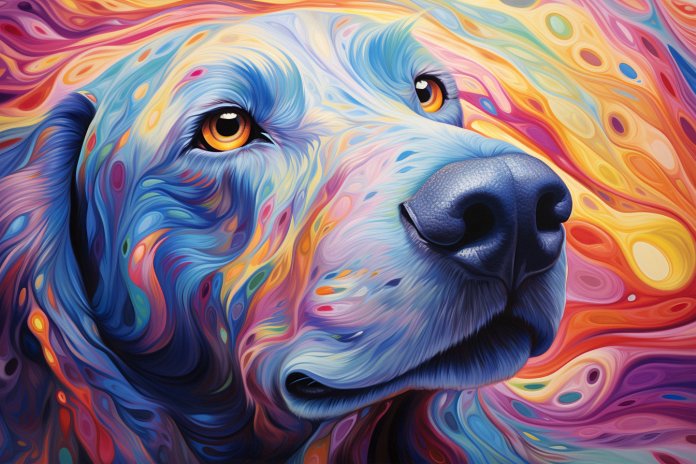
Where does the limit of a dog’s ability to smell things lie? Sniffer dogs have impressive abilities to detect various odors, from cocaine to explosives. Some dogs can even detect cancer in humans and warn their diabetic owners of low blood sugar levels. But can dogs smell something as small as genes? Actually, dogs cannot smell genes. Genes are odorless unless they code for a function that creates a smell, and even then, the dog detects the smell rather than the gene itself.
The Signs a Dog is Following a Scent
Dogs have different ways of scenting the air depending on the distance and location of the odor. When a detection dog is asked to follow a specific scent, they begin by widely sampling the air to determine where the smell is strongest. They move quickly in a zig-zag pattern and take shallow sniffs to find the path with the most intense smell. Once they localize the smell, they slow down to pinpoint it exactly.
In the detection world, this slow, deep sniffing is how dogs zero in on a concealed substance. Different types of detection dogs are trained to alert their handlers in specific ways, such as barking for explosives or lying down quietly for a cancer alert.
Body Language
When a dog is following a scent, there are clues in their body language. They may appear alert, pace, sniff, or hold their tail up. Other signs include “Flehmen” (curling their lip to better detect a scent), putting their head down while trotting forward, taking a zig-zag track, rapid shallow sniffing, and slow, deeper inhalations.
The History Behind Dogs Smelling
Dogs have always had a better sense of smell than humans, but certain breeds, like Bloodhounds and Beagles, are especially gifted. Originally used for hunting and tracking, dogs’ sense of smell has been utilized for more refined purposes, such as detecting explosives.
The Science of a Dog’s Sense of Smell
Dogs have evolved to have a superior sense of smell compared to humans. Their noses have more scent receptors, and their brains have a dedicated processing center for smells. The moist surface of a dog’s nose helps capture scent molecules, and their turbinate bones increase the surface area available for receiving scents. However, dogs still cannot detect genes with their sense of smell.
Training a Dog to Follow a Scent
While dogs cannot smell genes, they can be trained to track or follow scents. Starting in a distraction-free environment, owners can use a favorite toy to teach the dog to track its scent. By gradually increasing the difficulty and hiding locations, the dog will eventually rely on its sense of smell to find the toy.
In conclusion, dogs have incredible olfactory abilities, but they cannot smell genes. However, they can be trained to track scents using their highly sensitive noses.
“Dogs have an extraordinary sense of smell, but even they can’t detect genes. However, they can be trained to follow scents, a skill that taps into their natural talents.”

Tips & Things to Know
1️⃣ Dogs have an incredibly sensitive sense of smell, but they cannot detect genes. Genes are odorless unless they code for a function that creates a smell, and even then, dogs detect the smell rather than the gene itself.
2️⃣ When dogs are following a scent, they start by widely sampling the air to determine where the smell is strongest. Once they have localized the smell, they slow down and take deeper breaths to pinpoint it exactly. Different body language cues, such as pacing, sniffing, and tail up, indicate that a dog is honing in on an interesting smell.
3️⃣ Dogs have a superior sense of smell compared to humans due to adaptations of the nose and brain. Their sense of smell is 10,000 to 100,000 times more sensitive than the human nose. Dogs have a highly-tuned processing center in the brain and numerous scent receptors in the nose, allowing them to detect scents with great accuracy. However, they still cannot detect genes.
Frequently Asked Questions, Answered ✅
1. Can dogs smell genes?
No, dogs cannot smell genes as genes are odorless unless they code for a function that creates a smell. In that case, the dog detects the smell rather than the gene coding for it.
2. How do detection dogs locate a scent?
Detection dogs start by widely sampling the air to determine where the smell is strongest. They move forward rapidly in a zig-zag path, taking shallow sniffs. Once they localize the smell, they slow down to pinpoint it exactly.
3. What are the signs that a dog is following a scent?
When following a scent, you can expect to see signs such as alertness, pacing, sniffing, and a tail up. Other signs include flehmen, putting their head down while trotting forward, taking a zig-zag track, rapid shallow sniffing, and slow deeper inhalations.
4. Why do some dog breeds have a superior sense of smell?
Some dog breeds, such as Bloodhounds and Beagles, have specialized further in scenting abilities due to selective breeding. Originally used for hunting and tracking, these breeds have adapted to have super-gifted noses.
5. How does a dog’s sense of smell compare to humans?
A dog’s sense of smell is 10,000 to 100,000 times more sensitive than the human nose. This is due to a highly-tuned processing center in the brain, an increased number of scent receptors in the nose, and a larger olfactory center dedicated to smell.